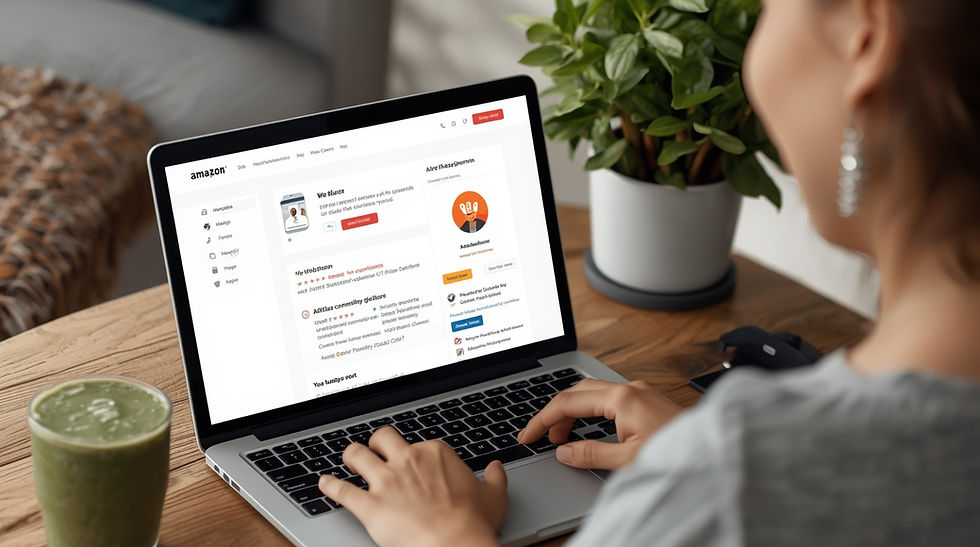Earn from Day One: Monetizing a New Health & Wellness Blog
- MTK Marketing LLC
- Sep 10
- 6 min read
Disclosure: I may earn a small commission for purchases made through affiliate links in this post at no extra cost to you. I only recommend products I truly believe in. Thank you for supporting my site!

You're passionate about health and wellness. You've done the research, chosen a niche, and are ready to share your knowledge with the world. But a daunting question lingers: how long will it take to actually make money from this blog?
Conventional wisdom says to focus on content for 6 months before even thinking about monetization. This is outdated advice that costs you time, momentum, and valuable income data.
The truth is, you can—and should—build monetization into your strategy from the very first day. This doesn't mean bombarding your first ten readers with spammy ads. It means strategically laying the groundwork for income streams that can grow alongside your traffic.
This guide will show you how to approach your new health and wellness blog with an "earn from day one" mindset.
We'll cover the foundational mindset shift, the exact affiliate programs to join immediately, how to land sponsored posts faster, and how to use your existing expertise to create quick digital products. Let's build a blog that supports your well-being and your wallet from the start.
Part 1: The Mindset Shift - Monetization is Part of the Journey, Not the Destination
The biggest mistake new bloggers make is treating monetization as a separate phase that begins after they've "made it." This is a flawed approach.
Monetization is Data: Every affiliate link clicked and every product purchased provides invaluable data on what your audience actually wants and will pay for. Waiting months to collect this data puts you at a disadvantage.
It Sets the Tone: When you integrate monetization thoughtfully from the beginning, it becomes a natural part of your blog's ecosystem. Your early audience grows accustomed to you making recommendations.
It Funds Your Growth: Early income, even if small, can be reinvested into better hosting, a email marketing service, or paid advertising to accelerate your growth.
Your goal isn't to make a full-time income on day one. Your goal is to have the systems in place so that when the traffic comes, the money starts flowing automatically.
Part 2: Foundation First - The Pre-Launch Monetization Checklist
Before you publish your first post, complete these steps to ensure you're ready to earn.
Build on WordPress.org (Not .com): This is non-negotiable for monetization. A self-hosted WordPress.org site gives you full control to run ads, install plugins, and truly own your content. Use a beginner-friendly host like Bluehost or SiteGround.
Install Essential Legal Pages: Immediately add a Privacy Policy and Disclosure page. These are required by law (like the FTC) and by affiliate programs. They protect you and build trust with your audience by being transparent about how you make money.
Set Up Google Analytics: From day one, you need to track what content resonates and where your traffic is coming from. This data is crucial for making smart monetization decisions later.

Part 3: Day-One Monetization Strategy #1: Affiliate Marketing
Affiliate marketing is the fastest way to start earning. You recommend products you use and love, and earn a commission on sales made through your special links.
Affiliate Programs to Join Immediately:
Amazon Associates: The easiest to get into. You can link to virtually any health product—from vitamin supplements and yoga mats to blenders and health books. While commissions are low (1-4%), the conversion rate is high because people trust Amazon.
Awin / CJ Affiliate: These are networks that house thousands of individual affiliate programs. Apply for programs relevant to your niche:
iHerb, Vitacost: For vitamins and supplements.
Gaiam, Manduka: For yoga and fitness gear.
MyFitnessPal Premium, Cronometer: For nutrition tracking apps.
Thrive Market: For healthy groceries (perfect for holistic nutrition blogs).
Brand-Specific Programs: Many direct-to-consumer wellness brands have their own generous affiliate programs. Look for a link in the footer of your favorite brands' websites that says "Affiliates" or "Partners."
How to Implement Affiliate Links Ethically as a New Blog:
Weave Links into Content Naturally: Your first blog posts should be helpful, foundational content for your niche. Within that content, mention products you genuinely use.
Post Idea: "My Morning Routine for Balanced Energy"
Natural Integration: "I start my day with a large glass of water from this simple glass pitcher (affiliate link) I love. Then, I add a scoop of this collagen peptides (affiliate link) to my coffee for a protein boost."
Create "Gear" or "Resources" Pages: Create a page titled "My Favorite Wellness Products" or "Shop My Kitchen." List every product you use with affiliate links. Then, link to this page from your homepage, sidebar, and within relevant blog posts. This becomes a powerhouse of affiliate income over time.
Always Disclose: Use clear language like, "This post contains affiliate links. I may earn a small commission if you make a purchase through my links, at no extra cost to you. I only recommend products I truly love and use."
Part 4: Early Monetization Strategy #2: Sponsored Posts & Brand Partnerships
You might think brands only work with big bloggers. This isn't true. Micro-influencers ( bloggers with 1k-10k followers) often have higher engagement rates. Brands are looking for authentic voices.
How to Attract Brands from the Beginning:
Create a Professional Media Kit: This is your blog's resume. Even with small stats, you need one. It should include:
Your blog's name, logo, and a one-sentence description.
A short bio and your photo.
Your audience demographics (age, interests, location - use Google Analytics data).
Your stats (pageviews, unique monthly visitors, email list size, social media followers).
Examples of previous work (even if it's just your best blog posts).
Services you offer (e.g., sponsored posts, product reviews, social media shares).
Canva has excellent free media kit templates.
Pitch Yourself to Small Brands: Don't wait for brands to find you.
Identify Brands You Love: Look for smaller, mission-driven health brands that align with your values.
Craft a Personalized Pitch: Send a short, friendly email to the founder or marketing manager. Introduce yourself, explain why you love their product specifically, and propose a collaboration. Example: "I could create a blog post titled '3 Delicious Smoothie Recipes Using [Your Product]' and share it with my engaged Instagram audience."
Offer Value First: For your first collaboration, you might accept free product in exchange for a post. This builds your portfolio and relationship with the brand.

Part 5: Monetization Strategy #3: Offer Services Based on Your Expertise
Your knowledge has value right now. Even as a new blogger, you can offer low-touch, high-value services.
Health Coaching / Consulting: If you have credentials or deep lived experience, offer 1:1 coaching sessions. Create a "Work With Me" page to detail your services.
Menu Planning Services: Offer to create custom weekly meal plans for clients based on their dietary needs (e.g., vegan, gluten-free, PCOS-friendly).
Blogger for Hire: Offer your writing services to other health brands or larger blogs in your niche. This builds your authority and provides income.
Part 6: Building Your Email List: Your #1 Asset for Future Income
Your email list is your most valuable monetization tool. You own it, and it allows you to communicate directly with your biggest fans.
Start from Day One: Add an email opt-in form to your website's sidebar and footer immediately.
Offer a "Lead Magnet": This is a freebie you give away in exchange for an email address. For a health blog, this could be:
"A 3-Day Clean Eating Meal Plan"
"My Top 5 Healthy Smoothie Recipes"
"A Printable Guide to Beating the Afternoon Slump"
Create this in Canva and deliver it as a PDF.
Use an Email Service Provider: MailerLite is a fantastic free option to start with. It allows you to automate your welcome email that delivers the lead magnet.
Your email list is your direct line to pitch your future digital products, coaching services, and affiliate recommendations.

Part 7: What to Avoid: Monetization Mistakes for New Bloggers
Don't Use Display Ads Early: Avoid Google AdSense until you have significant traffic (at least 10k pageviews/month). Low-traffic ads pay pennies and make your site look spammy and slow to load, which will drive your precious early readers away.
Don't Promote Products You Don't Believe In: Your credibility is your only currency. Never promote a supplement, tea, or gadget just for the commission. Your authentic recommendation is what will make your blog successful in the long run.
Don't Be Afraid to Pitch: The worst a brand can say is "not yet." You miss 100% of the shots you don't take.
Final Thoughts: Your Authority Starts Now
You don't need a massive audience to start making money. You need a strategic mindset, a focus on providing genuine value, and the confidence to put yourself out there.
Your journey to a profitable health and wellness blog begins not after you get traffic, but as you build it. By integrating these monetization tactics from the start, you're not being salesy; you're building a sustainable business around your passion.
Take action today. Join one affiliate program. Outline your lead magnet. Your future income starts with the steps you take right now.
Your assignment: Before you publish your next post, choose one affiliate program from this list and apply. Then, find one place in your drafted content to naturally include a relevant affiliate link.
For more on managing your new blogging income, learn how to create a realistic budget that works for variable income.



Comments